Abstract
Antagonism between (-)-N6-phenylisopropyladenosine (PIA) and the dihydropyridine calcium channel facilitator Bay K 8644 was investigated in guinea-pig spontaneously beating or electrically driven isolated atria, taken from normal and from reserpine-treated animals. PIA (3-100 nM) produced a dose-dependent decrease in contractile tension and frequency in spontaneously beating atria being more effective in reserpinized preparations. Bay K 8644 (5-200 nM) produced an increase in contractile tension in both normal and reserpinized atria. In electrically driven left atria the positive inotropic effect of Bay K 8644 was similar to that in spontaneously beating preparations. The positive chronotropic effect of Bay K 8644 was slight and variable. PIA produced a rightward parallel shift of the concentration-response curves for the positive inotropic effects of Bay K 8644 in all experimental conditions. In spontaneously beating atria from normal guinea-pigs, the Schild regression plot was linear and its slope near to unity; pA2 of PIA 8.63 +/- 0.05 (IC50 2.35 +/- 0.25 nM). In electrically driven atria the antagonism by PIA of the effects of Bay K 8644 was apparently competitive, and the IC50 of PIA was 18.6 +/- 0.4 nM. PIA antagonized the positive chronotropic effect of Bay K 8644 in spontaneously beating preparations, both from normal and from reserpine-treated animals. Carbachol did not modify the positive inotropic effects of Bay K 8644. These data indicate that PIA may interact with Bay K 8644 at the level of the slow calcium channels, and may decrease the transmembrane calcium flux into the cell.
Full text
PDF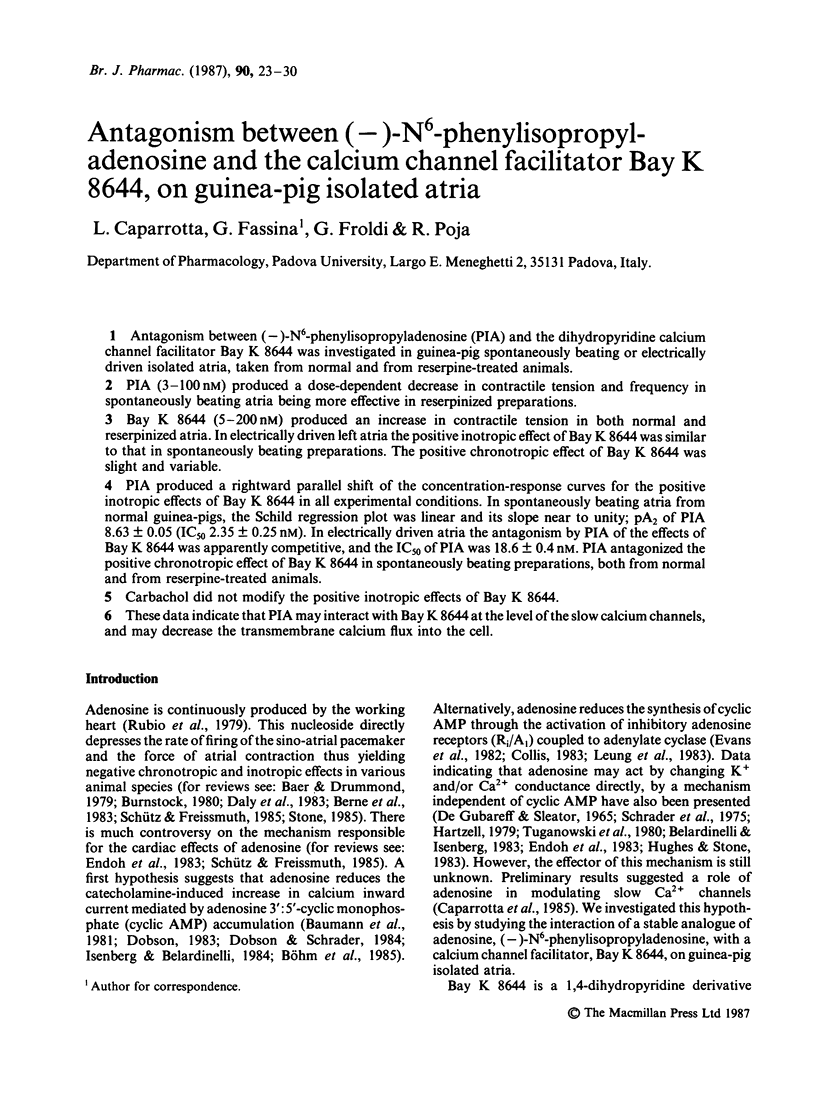

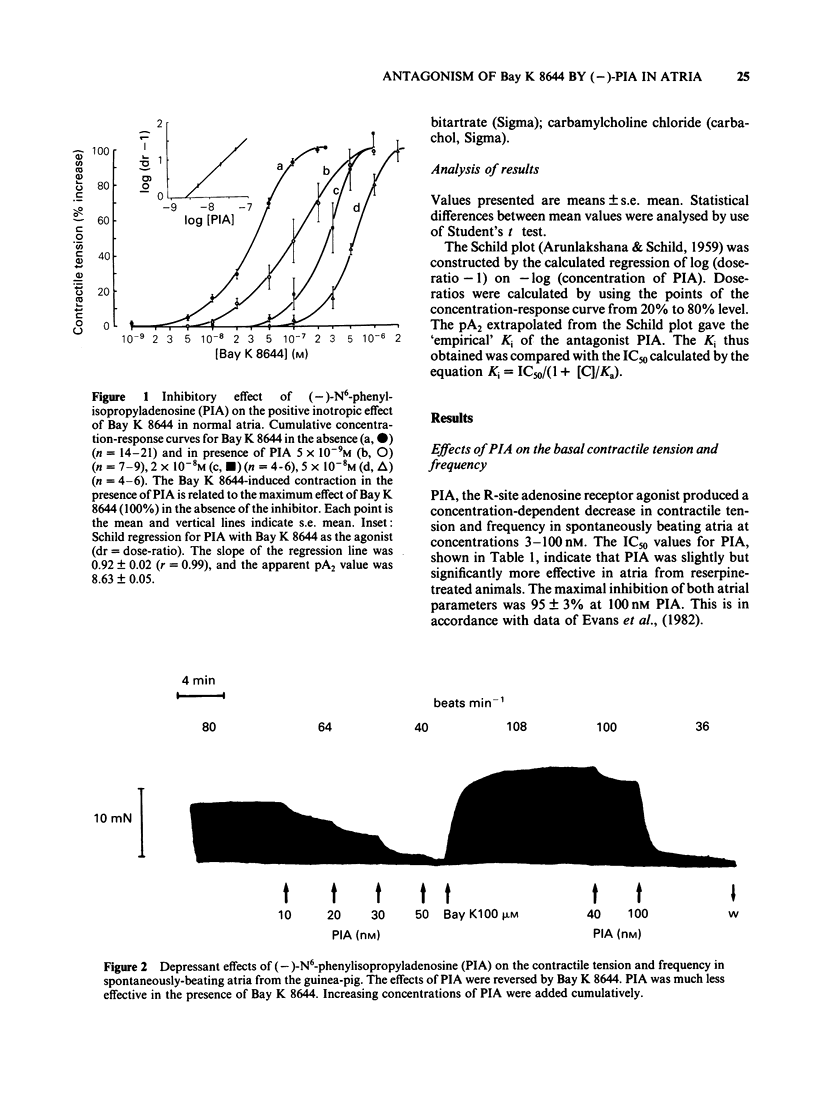

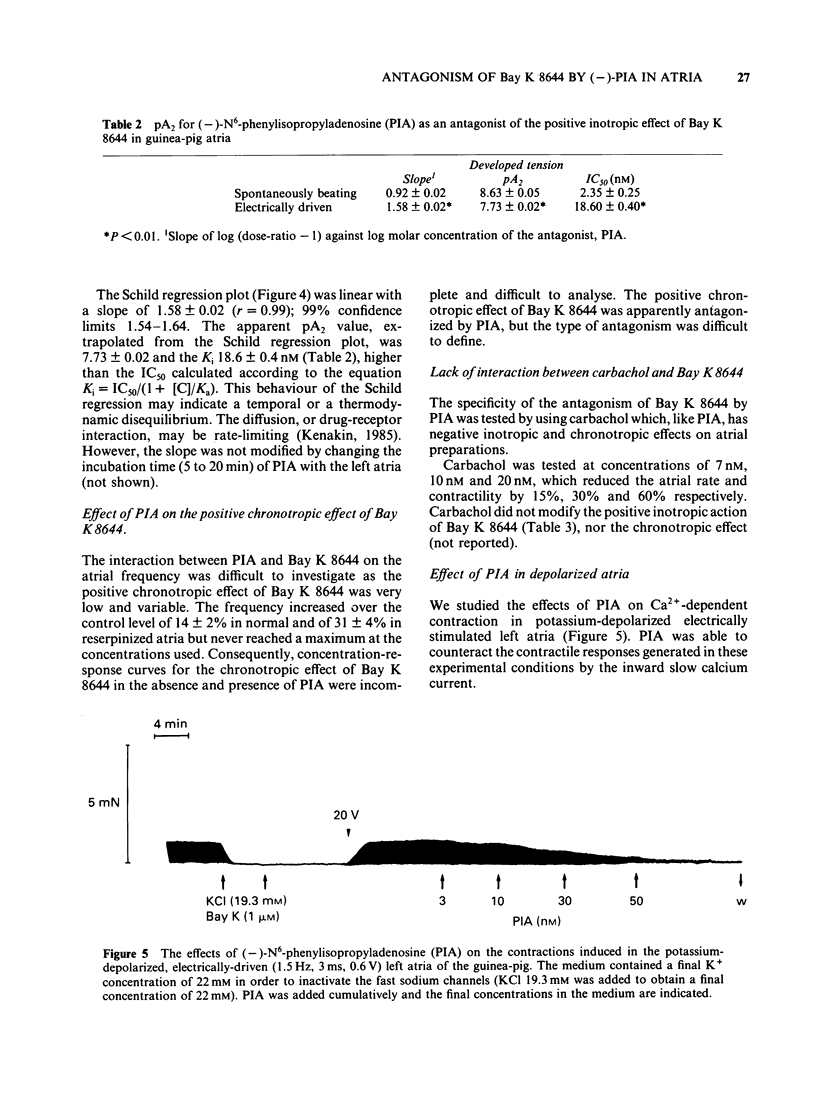

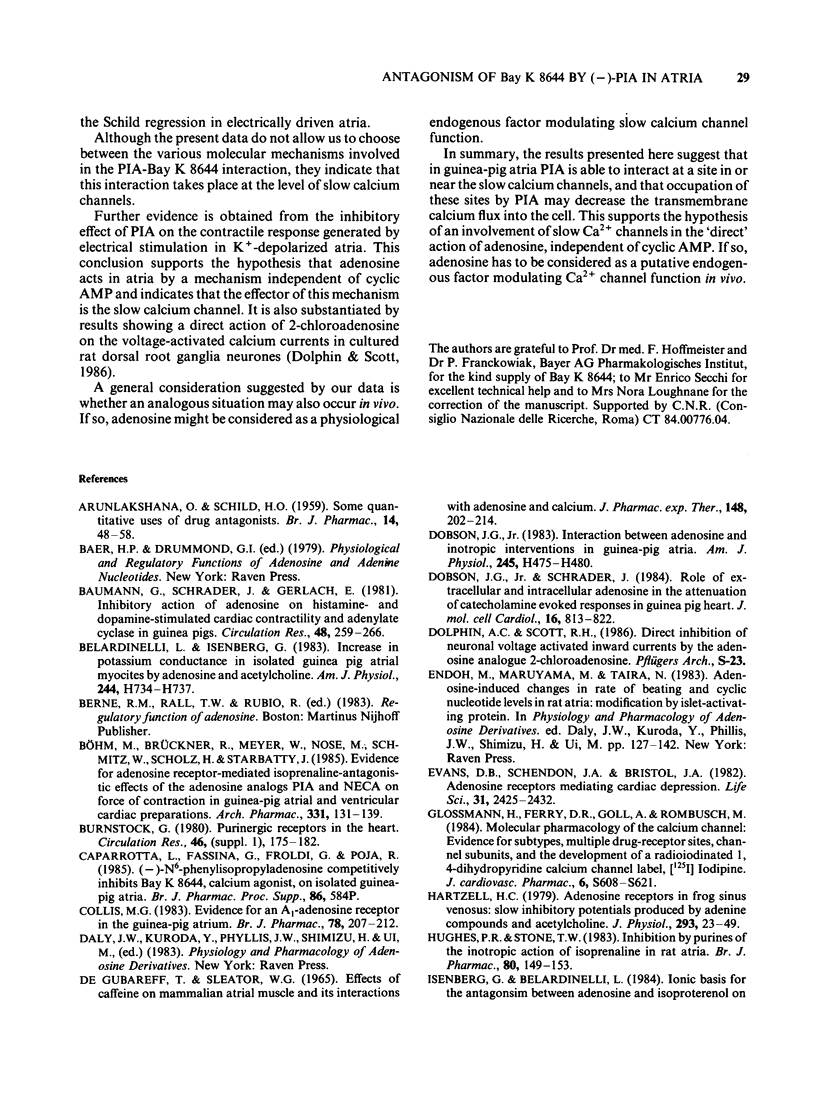
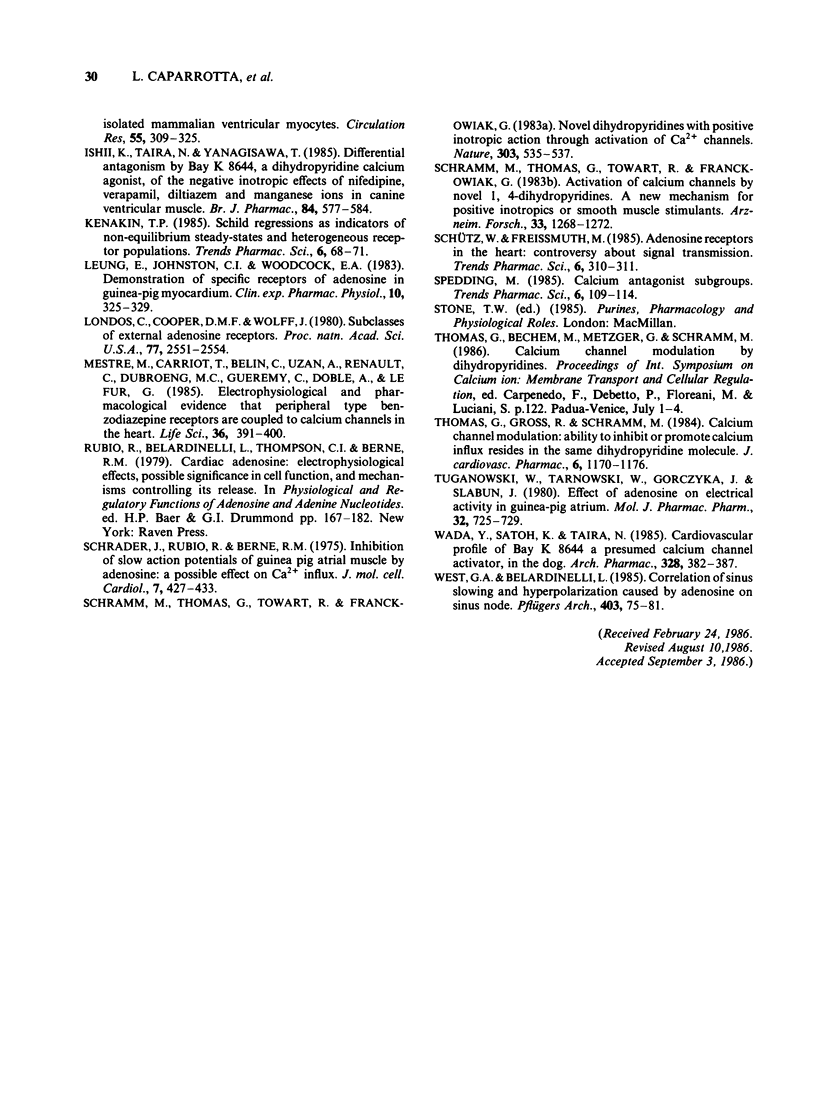
Selected References
These references are in PubMed. This may not be the complete list of references from this article.
- ARUNLAKSHANA O., SCHILD H. O. Some quantitative uses of drug antagonists. Br J Pharmacol Chemother. 1959 Mar;14(1):48–58. doi: 10.1111/j.1476-5381.1959.tb00928.x. [DOI] [PMC free article] [PubMed] [Google Scholar]
- Baumann G., Schrader J., Gerlach E. Inhibitory action of adenosine on histamine- and dopamine-stimulated cardiac contractility and adenylate cyclase in guinea pigs. Circ Res. 1981 Feb;48(2):259–266. doi: 10.1161/01.res.48.2.259. [DOI] [PubMed] [Google Scholar]
- Belardinelli L., Isenberg G. Isolated atrial myocytes: adenosine and acetylcholine increase potassium conductance. Am J Physiol. 1983 May;244(5):H734–H737. doi: 10.1152/ajpheart.1983.244.5.H734. [DOI] [PubMed] [Google Scholar]
- Böhm M., Brückner R., Meyer W., Nose M., Schmitz W., Scholz H., Starbatty J. Evidence for adenosine receptor-mediated isoprenaline-antagonistic effects of the adenosine analogs PIA and NECA on force of contraction in guinea-pig atrial and ventricular cardiac preparations. Naunyn Schmiedebergs Arch Pharmacol. 1985 Nov;331(2-3):131–139. doi: 10.1007/BF00634229. [DOI] [PubMed] [Google Scholar]
- Collis M. G. Evidence for an A1-adenosine receptor in the guinea-pig atrium. Br J Pharmacol. 1983 Jan;78(1):207–212. doi: 10.1111/j.1476-5381.1983.tb09381.x. [DOI] [PMC free article] [PubMed] [Google Scholar]
- DEGUBAREFF T., SLEATOR W., Jr EFFECTS OF CAFFEINE ON MAMMALIAN ATRIAL MUSCLE, AND ITS INTERACTION WITH ADENOSINE AND CALCIUM. J Pharmacol Exp Ther. 1965 May;148:202–214. [PubMed] [Google Scholar]
- Dobson J. G., Jr Interaction between adenosine and inotropic interventions in guinea pig atria. Am J Physiol. 1983 Sep;245(3):H475–H480. doi: 10.1152/ajpheart.1983.245.3.H475. [DOI] [PubMed] [Google Scholar]
- Dobson J. G., Jr, Schrader J. Role of extracellular and intracellular adenosine in the attenuation of catecholamine evoked responses in guinea pig heart. J Mol Cell Cardiol. 1984 Sep;16(9):813–822. doi: 10.1016/s0022-2828(84)80005-x. [DOI] [PubMed] [Google Scholar]
- Evans D. B., Schenden J. A., Bristol J. A. Adenosine receptors mediating cardiac depression. Life Sci. 1982 Nov 29;31(22):2425–2432. doi: 10.1016/0024-3205(82)90746-9. [DOI] [PubMed] [Google Scholar]
- Glossmann H., Ferry D. R., Goll A., Rombusch M. Molecular pharmacology of the calcium channel: evidence for subtypes, multiple drug-receptor sites, channel subunits, and the development of a radioiodinated 1,4-dihydropyridine calcium channel label, [125I]iodipine. J Cardiovasc Pharmacol. 1984;6 (Suppl 4):S608–S621. [PubMed] [Google Scholar]
- Hartzell H. C. Adenosine receptors in frog sinus venosus: slow inhibitory potentials produced by adenine compounds and acetylcholine. J Physiol. 1979 Aug;293:23–49. doi: 10.1113/jphysiol.1979.sp012877. [DOI] [PMC free article] [PubMed] [Google Scholar]
- Hughes P. R., Stone T. W. Inhibition by purines of the inotropic action of isoprenaline in rat atria. Br J Pharmacol. 1983 Sep;80(1):149–153. doi: 10.1111/j.1476-5381.1983.tb11060.x. [DOI] [PMC free article] [PubMed] [Google Scholar]
- Isenberg G., Belardinelli L. Ionic basis for the antagonism between adenosine and isoproterenol on isolated mammalian ventricular myocytes. Circ Res. 1984 Sep;55(3):309–325. doi: 10.1161/01.res.55.3.309. [DOI] [PubMed] [Google Scholar]
- Ishii K., Taira N., Yanagisawa T. Differential antagonism by Bay k 8644, a dihydropyridine calcium agonist, of the negative inotropic effects of nifedipine, verapamil, diltiazem and manganese ions in canine ventricular muscle. Br J Pharmacol. 1985 Feb;84(2):577–584. doi: 10.1111/j.1476-5381.1985.tb12943.x. [DOI] [PMC free article] [PubMed] [Google Scholar]
- Leung E., Johnston C. I., Woodcock E. A. Demonstration of specific receptors for adenosine in guinea-pig myocardium. Clin Exp Pharmacol Physiol. 1983 May-Jun;10(3):325–329. doi: 10.1111/j.1440-1681.1983.tb00206.x. [DOI] [PubMed] [Google Scholar]
- Londos C., Cooper D. M., Wolff J. Subclasses of external adenosine receptors. Proc Natl Acad Sci U S A. 1980 May;77(5):2551–2554. doi: 10.1073/pnas.77.5.2551. [DOI] [PMC free article] [PubMed] [Google Scholar]
- Mestre M., Carriot T., Belin C., Uzan A., Renault C., Dubroeucq M. C., Guérémy C., Doble A., Le Fur G. Electrophysiological and pharmacological evidence that peripheral type benzodiazepine receptors are coupled to calcium channels in the heart. Life Sci. 1985 Jan 28;36(4):391–400. doi: 10.1016/0024-3205(85)90126-2. [DOI] [PubMed] [Google Scholar]
- Schrader J., Rubio R., Berne R. M. Inhibition of slow action potentials of guinea pig atrial muscle by adenosine: a possible effect on Ca2+ influx. J Mol Cell Cardiol. 1975 Jun;7(6):427–433. doi: 10.1016/0022-2828(75)90048-6. [DOI] [PubMed] [Google Scholar]
- Schramm M., Thomas G., Towart R., Franckowiak G. Activation of calcium channels by novel 1,4-dihydropyridines. A new mechanism for positive inotropics or smooth muscle stimulants. Arzneimittelforschung. 1983;33(9):1268–1272. [PubMed] [Google Scholar]
- Schramm M., Thomas G., Towart R., Franckowiak G. Novel dihydropyridines with positive inotropic action through activation of Ca2+ channels. Nature. 1983 Jun 9;303(5917):535–537. doi: 10.1038/303535a0. [DOI] [PubMed] [Google Scholar]
- Thomas G., Gross R., Schramm M. Calcium channel modulation: ability to inhibit or promote calcium influx resides in the same dihydropyridine molecule. J Cardiovasc Pharmacol. 1984 Nov-Dec;6(6):1170–1176. [PubMed] [Google Scholar]
- Tuganowski W., Tarnowski W., Gorczyca J., Sałabun J. Effect of adenosine on electrical activity in guinea-pig atrium. Pol J Pharmacol Pharm. 1980 Sep-Oct;32(5):725–729. [PubMed] [Google Scholar]
- Wada Y., Satoh K., Taira N. Cardiovascular profile of Bay K 8644, a presumed calcium channel activator, in the dog. Naunyn Schmiedebergs Arch Pharmacol. 1985 Feb;328(4):382–387. doi: 10.1007/BF00692905. [DOI] [PubMed] [Google Scholar]
- West G. A., Belardinelli L. Correlation of sinus slowing and hyperpolarization caused by adenosine in sinus node. Pflugers Arch. 1985 Jan;403(1):75–81. doi: 10.1007/BF00583285. [DOI] [PubMed] [Google Scholar]


